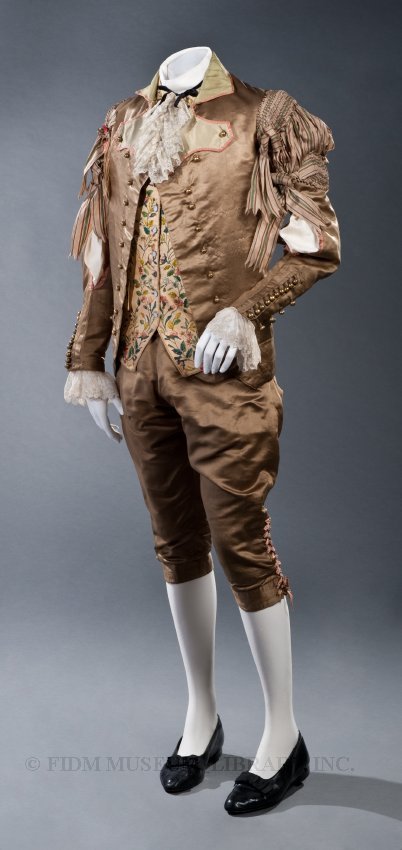For my first blog post as the FIDM Museum’s new Social Media Manager, I could not resist writing about an extraordinary survival from my favorite period in fashion history: the eighteenth century.
Figaro Costume (Jacket, Vest, Breeches)
Europe, 1790-1810
Silk satin, silk ribbon, cotton sateen, silk floss, mirrors & metallic sequins
2011.13.34A-C
This rare theater costume is currently on display as part of the FIDM Museum exhibition Opulent Art: 18th-Century Dress from The Helen Larson Historic Fashion Collection. The fanciful suit is typical of the kind traditionally worn onstage by Figaro, the scheming hero of Pierre Augustin Caron de Beaumarchais’ plays The Barber of Seville and The Marriage of Figaro, which were turned in to operas by Gioachino Rossini and Wolfgang Amadeus Mozart. The FIDM Museum is proud to exhibit it as part of the Los Angeles Opera's ongoing Figaro Unbound cultural festival.
Based on the dress of the Spanish majo—a working-class dandy—the suit incorporates seventeenth-century details such as slashed, beribboned sleeves and laced-up cuffs, which survived in conservative Spain long after going out of style elsewhere. In contrast to the opulence of the elaborately embroidered elite garments displayed elsewhere in the gallery, actors in the wildly popular play wore rural, Spanish-accented dress, which started a trend for rustic simplicity among the French aristocracy. Figaro’s adventures undermining his aristocratic employers sparked revolutionary tensions with real-life rulers, who tried unsuccessfully to ban the production.
The topsy-turvy world of The Marriage of Figaro–where it is impossible to tell boy from girl or maid from mistress–has much in common with modern-day Los Angeles. In a town where dressing up means wearing your good jeans, we can easily relate to the way Figaro made informal, working-class garments look chic. Casual Fridays are common in the business world, and many companies extend the ethos to the whole workweek. The recent history of fashion is full of examples of the very rich imitating the very poor, and the practice remains controversial; think of Marc Jacobs’ “grunge” collection of 1992, or John Galliano’s 2000 haute couture collection for Christian Dior, inspired by the homeless.
At the same time, though, it’s become much easier for the poor to imitate the dress of the rich. In the 18th century, new clothing was prohibitively expensive for most of the population, and fashionable clothing—which would go out of style long before it wore out—was a rare luxury. Today, thanks to manmade fibers, inexpensive purveyors of “fast fashion,” and services like Rent the Runway, dressing well on a budget has never been easier. Once again, it’s difficult to tell maid from mistress at a glance.
Join the FIDM Museum and the Los Angeles Opera for a free concert in Grand Hope Park featuring highlights from the Figaro operas this Saturday, March 28, at 3 pm. Be sure to stop by the adjacent Museum (open 10-5) for a peek at our own Figaro.



Love the design and style!
Thanks for the catch!